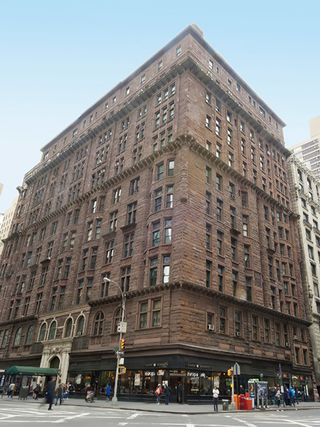 Carter Horsley
Carter HorsleyDec 23, 2011
Carter's Review
An adulterated residential fortress, the Osborne, which was built in 1883, was one of New York's first major luxury apartment buildings and despite its somber appearance is palatial.
While the façades are a heavily rusticated combination of the Romanesque Revival and Italian Renaissance Palazzo styles in dark reddish brown stone, the lobby is a luminous Byzantine dream of gilded tiles with contributions by Augustus St. Gaudens, the great sculptor of the American Renaissance, muralist John La Farge, Tiffany Studios and French designer Jacob Adolphus Holzer. For those privileged to live or visit here, the romance of secret treasures is not fictional. No other apartment building can boast as sumptuous and dazzling lobby.
In 1889, Ware raised the roof to add servants quarters and seventeen years later a 25-foot-wing was added at its western end.
The building is often overshadowed in public awareness by the Dakota, further uptown on Central Park West, but the Osborne is more fascinating even if it is not as attractive on the exterior and its apartments are not quite as spectacular. What is intriguing about the Osborne is that, as a result of two major alterations in 1899 and 1906 its interior layouts are complex. The 1906 extension skillfully added more bedrooms to adjoining apartments. Most of the units have 15-foot-high ceilings facing 57th Street, but the rear of the building is split into many shorter levels and many of the large apartments have been subdivided over the years and the building's interior subsequently is rather labyrinthine. A rear one-bedroom apartment, for example, might have its entrance on an intermediate floor between floors 7 and 8 and have a grand entrance hall with 14-foot ceilings with a quite grand staircase leading down to a spacious living room, bedroom and kitchen.
This and the Carnegie Hall Studios above the concert hall diagonally across Seventh Avenue from this building are the easiest buildings in the city in which to get lost.
Period photographs indicate that the building's exterior has suffered much over the years. The three large protruding courses once supported very handsome balustrades. The top one, the widest, was meant to serve as a cornice although it was actually two stories beneath the roofline in an attempt to make the building seem somewhat smaller than it actually was. A much more modest cornice was at rooftop. The rooftop, incidentally, was not originally even, and was higher on 57th Street than on Seventh Avenue. Subsequently, the whole of the Seventh Avenue cornice line was raised to add rooms on the top floor.
The building originally was planned to have a billiard room, a florist, a resident doctor and druggist and "on the roof, a lawn for playing croquet," according to a Real Estate Record and Guide article in 1884 quoted by Andrew Alpern in his essay on the building in his excellent book, "Luxury Apartment Houses of Manhattan, An Illustrated History," 1992, (Dover Publications Inc., New York).
The developer, Thomas Osborne, was a stone contractor but he ran into financial difficulties during construction. A February 6, 1994 column by Christopher Gray in The New York Times remarked that "this huge clunky mass neatly defeats stylistic description, and it is really the vernacular of the practical building, quite innocent of aesthetic pretension," adding that The Real Estate Record & Guide, "unappreciative of the comic transparency of Osborne's effort, called the façade 'crude and unskillful.'
The building was completed by John Taylor, a hotel operator. James Edward Ware was the original architect and Alfred S. G. Taylor and Julien Clarence Levi were the architects for the 1906 extension.
In 1961, the building was sold to a developer who planned to raze it and replace it with a new 17-story apartment building, designed by Robert Bien, but fortunately the residents organized its purchase and conversion into a cooperative the next year.
The Osborne, obviously, has not stood still for the test of time. Perhaps the saddest loss occurred in 1919 when the protruding porte-coch¿re entrance and the low balustraded "moat" that surrounded the building were removed. The porte-cochere should be replaced and the building does need a major cornice at the top and the lower protrusions should have their lovely balustrades recreated. The entrance canopy is pleasant, but the porte-cochere was terrific.
Such improvements would enhance the structure and be fitting historically, but this will never be a handsome building. It is simply a Gothic force, a Victorian/Edwardian bundle of architectural baggage containing residences fit for nobility. Some critics have been enamored of the heavy-handed style of Henry Richardson who would most likely have loved to live here. Perhaps more than any other building, including the not unimpressive Federal Reserve Bank Building in Lower Manhattan, this is a presence, a pile of architecture that manifests great power. The hell with style and grace and feminine virtues - this is a building in which to enjoy a good cigar! Pomp and circumstance indeed!
The building was designated an official city landmark in 1991.

- Co-op built in 1885
- 4 apartments currently for sale ($699K to $6.499M)
- Located in Midtown West
- 111 total apartments 111 total apartments
- 10 recent sales ($390K to $2.7M)
- Doorman
- Pets Allowed
 6sqft delivers the latest on real estate, architecture, and design, straight from New York City.
6sqft delivers the latest on real estate, architecture, and design, straight from New York City.
